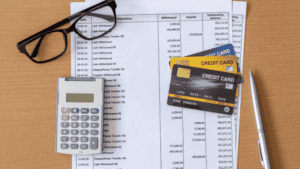Debt can be overwhelming, especially if you’re managing multiple high-interest obligations like credit cards, student loans, and medical bills.
Using home equity is one way to consolidate debts, potentially reducing interest costs and simplifying monthly payments.
We’ll explain the step-by-step process of using home equity to pay off debt to help you decide if this approach suits you.
Understanding home equity
Home equity is the portion of your home that you fully own.
Equity is calculated by finding the difference between the value of your home and the amount of money you still owe on your mortgage.
The median home price last year was $412,000. In this situation, if you still owed $150,000 on your mortgage, you would have $262,000 of ownership in your home.
You can tap into your home equity in different ways, such as getting a home equity loan, doing a cash-out refinance, or applying for a home equity line of credit (HELOC).
Each option has pros and cons, depending on your financial situation and goal.
Step 1: Assess your financial situation
To use home equity to pay off debt, list all your debts and note interest rates, minimum payments, and balances.
Determine your home’s market value and calculate your available equity—lenders typically allow borrowing up to 80%.
Finally, review your income and expenses to ensure you can manage the new monthly payment, as missed payments could put your home at risk.
Step 2: Choose the right home equity option
After assessing your financial situation, choose the right home equity option for paying off your debt. There are three primary ways to access your home equity:
Home equity line of credit (HELOC)
A HELOC functions like a credit card, using your home’s value as collateral.
You can borrow as needed during the draw period (typically ten years), often paying only interest. Afterward, you’ll repay both the principal and interest.
A HELOC is ideal for flexible borrowing or ongoing expenses, but keep in mind that variable interest rates can result in fluctuating payments.
Access cash within days
Tap into your home’s potential in minutes. Start our streamlined digital application to discover if a HELOC is right for you.
Home equity loan
With this home loan, you can borrow a one-time amount using your home’s equity and pay it back over a fixed term with a set interest rate.
This option suits those who prefer regular monthly payments and a predictable repayment schedule and those who know how much they need to borrow.
Homeowners often use home equity loans to consolidate high-interest debts, as they typically offer lower interest rates than credit cards and personal loans.
Cash-out refinance
Cash-out refinance loans allow you to refinance your mortgage for a higher amount than your current balance and receive the difference in cash.
This can consolidate debt into a new mortgage with a potentially lower interest rate, reducing monthly payments. However, this also extends your mortgage term, meaning you’ll be paying interest for longer.
Step 3: Apply for your chosen home equity option
Once you’ve selected the best home equity option, it’s time to apply. Here’s what you’ll need:
Gather necessary documents
Lenders require several documents to assess your application, including:
- Proof of income (pay stubs, tax returns, or bank statements)
- Proof of homeownership (a copy of your mortgage statement)
- Proof of your home’s value (an appraisal or recent sales data)
- Details about your debts (loan statements, credit card bills, etc.)
Compare lenders
Before choosing a loan, check out offers from different lenders.
Pay attention to factors such as interest rates, extra fees, and loan terms to ensure you’re getting the best deal.
Also, consider the closing costs, which can be different for each lender and affect the loan’s cost.
Submit your application
Once you have picked a lender, complete and submit an application and provide the necessary paperwork.
The lender will look at your financial situation and might ask for an evaluation of the property.
Once you get the green light, you will get the loan or credit line and can use the money to pay off your debts.
Step 4: Pay off your debts
After you get a loan or line of credit, you can use the money to pay off your high-interest debts.
- If you begin by paying off the higher interest-rate debts, you can save the most money in the long run.
- Once you’ve paid off your debts, try not to get into more debt.
- Make a budget that includes your new monthly payment and stick to it.
You can also use any extra money to make additional payments on your loan or HELOC—this will help you pay off the loan faster and save money on interest.
Step 5: Monitor your progress, making adjustments as you go
After using the value of your home to pay off what you owe, it’s important to keep an eye on your finances.
Stay on top of your new loan or HELOC balance and make your payments on time to avoid extra fees or the possibility of losing your home.
Regularly reviewing your budget and making changes if needed is also a good idea.
Remember to monitor your credit score as well. Paying off high-interest debts can steadily boost your credit score, leading to a stronger overall financial position.
Is using home equity to pay off debt right for you?
Using the equity in your home to pay off debt can be an effective financial strategy, but it comes with a few risks.
Consider whether this approach aligns with your financial goals and whether you can manage the potential risks—including the possibility of foreclosure if you miss payments.
If you’re uncertain whether using home equity is the right choice, consult a financial advisor who can help you assess your options and make an informed decision.
How to use home equity to pay off debt—closing thoughts
Tapping into your home equity can be a powerful way to pay off high-interest debt, simplify your finances, and save money on interest.
Staying disciplined, avoiding new debt, and monitoring your progress can help you ensure long-term financial success.
Finding equity solutions to your debt headaches
Interested in learning more about using home equity to pay off debt? Check out the fast and easy digital application that HomeEQ offers homeowners.
We can help. Contact HomeEQ today to learn how we make using home equity easy.




